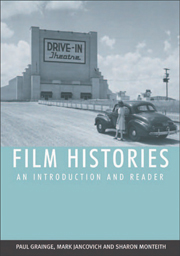Book contents
- Frontmatter
- Contents
- Preface
- Part I Film History from its Origins to 1945
- Part II Film History from 1946 to the Present
- 13 Postwar Challenges: National Regeneration, HUAC Investigations, Divestiture and Declining Audiences
- 14 The Politics of Polarisation: Affluence, Anxiety and the Cold War
- 15 Cinematic Spectacles and the Rise of the Independents
- 16 New Waves, Specialist Audiences and Adult Films
- 17 Radicalism, Revolution and Counter-Cinema
- 18 Modernism, Nostalgia and the Hollywood Renaissance
- 19 From Movie Brats to Movie Blockbusters
- 20 The Exhibitors Strike Back: Multiplexes, Video and the Rise of Home Cinema
- 21 Postmodernism, High Concept and Eighties Excess
- 22 Cults, Independents and ‘Guerrilla’ Filmmaking
- 23 From Cinemas to Theme Parks: Conglomeration, Synergy and Multimedia
- 24 Globalisation and the New Millennium
- Bibliography
- Copyright Acknowledgements
- Index
13 - Postwar Challenges: National Regeneration, HUAC Investigations, Divestiture and Declining Audiences
from Part II - Film History from 1946 to the Present
Published online by Cambridge University Press: 05 August 2013
- Frontmatter
- Contents
- Preface
- Part I Film History from its Origins to 1945
- Part II Film History from 1946 to the Present
- 13 Postwar Challenges: National Regeneration, HUAC Investigations, Divestiture and Declining Audiences
- 14 The Politics of Polarisation: Affluence, Anxiety and the Cold War
- 15 Cinematic Spectacles and the Rise of the Independents
- 16 New Waves, Specialist Audiences and Adult Films
- 17 Radicalism, Revolution and Counter-Cinema
- 18 Modernism, Nostalgia and the Hollywood Renaissance
- 19 From Movie Brats to Movie Blockbusters
- 20 The Exhibitors Strike Back: Multiplexes, Video and the Rise of Home Cinema
- 21 Postmodernism, High Concept and Eighties Excess
- 22 Cults, Independents and ‘Guerrilla’ Filmmaking
- 23 From Cinemas to Theme Parks: Conglomeration, Synergy and Multimedia
- 24 Globalisation and the New Millennium
- Bibliography
- Copyright Acknowledgements
- Index
Summary
It is ubiquitous to state that the United States emerged from the Second World War as the international superpower but the wider effects on film history were socio-economic. In an economy lifted out of the Depression by the war and readjusting to peace in an evolving Cold War context, the industry enjoyed the last significant boom before facing a crisis in the 1950s. To begin with, the studios continued to enjoy the boom they had had during the war with film comedy, as when Paramount's Bob Hope saved Madeleine Carroll from Nazi spies in My Favorite Blonde (1942). In the postwar years his winning comic formula was copied by Red Skelton and the most popular postwar comic Danny Kaye. RKO's The Bells of St Mary's starring Ingrid Bergman and Bing Crosby was the studio's biggest success ever in 1945 and conflict itself proved a creative force with the most successful postwar films at the box office drawing on the war as a catalyst for drama, as in Britain with David Lean's almost-love story Brief Encounter (1945) and Carol Reed's The Third Man (1949). Starring Joseph Cotten, Alida Valli, Orson Welles and Trevor Howard, Reed's story of postwar racketeering, murder and intrigue was internationally acclaimed and remains iconic in its visualisation of war-torn Vienna augmented by the haunting zither playing of Anton Karas.
- Type
- Chapter
- Information
- Film HistoriesAn Introduction and Reader, pp. 279 - 304Publisher: Edinburgh University PressPrint publication year: 2007



